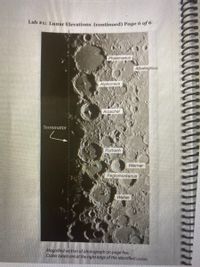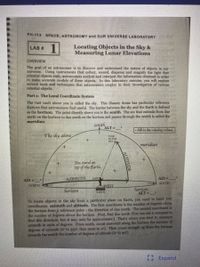
Applications and Investigations in Earth Science (9th Edition)
9th Edition
ISBN: 9780134746241
Author: Edward J. Tarbuck, Frederick K. Lutgens, Dennis G. Tasa
Publisher: PEARSON
expand_more
expand_more
format_list_bulleted
Question
Locating Objects in the sky and measuring lunar elevations. Lab for Space astronomy and our universe.
What the Aim of the experiment.
Data, calculations, and result sheet with the original record of measurements. 5. Results: consisting of tabulations and intermediate calculations and final results.
Discussion of the results
Conclusion: This should cover each point of your experiment.
2. Why do astronomers use the LCS?
Define the reference markings used to establish the LCS.
Define the two key coordinates. Describe the design and features of the two instruments used to locate a celestial object.

Transcribed Image Text:LAb #1: Lunar Elevations (continued) Page 6 of 6
Ptolemaeus
Albategnius
Alphonsus
Arzachel
Terminator
Purbach
Werner
Regiomontanus
Walter
Magnified section of photograph on page five.
Crater labels are at the right edge of the identified crater.

Transcribed Image Text:PH-112 SPACE, ASTRONOMY and OUR UNIVERSE LABORATORY
1
Locating Objects in the Sky &
Measuring Lunar Elevations
LAB #
OVERVIEW
The goal of an astronomer is to discover and understand the nature of objects in our
universe. Using instruments that collect, record, disperse and magnify the light that
celestial objects emit, astronomers analyze and interpret the information obtained in order
to make accurate models of these objects. In this laboratory exercise, you will explore
several tools and techniques that astronomers employ in their investigation of various
celestial objects.
Part 1: The Local Coordinate System
The vast vault above you is called the sky. This illusory dome has particular reference
features that astronomers find useful, The border between the sky and the Earth is defined
as the horizon. The point directly above you is the zenith. The are that extends from due
north on the horizon to due south on the horizon and passes through the zenith is called the
meridian.
zenith
ALT =
• Fill in the missing vahues.
The sky above
STAR
IN THE
SKY-
meridian
You stand on
top of the Earth.
AZI =
AZIMUTH
EAST
AZI =
SOUTH
NORTH
WEST
horizon
horizon
ALT=
EARTH
To locate objects in the sky from a particular place on Earth, you need to know two
coordinates: azimuth and altitude. The first coordinate is the number of degrees along
the horizon from a reference point - the direction of due north, The second coordinate is
the number of degrees above the horizon. First, find due north (You can use a compass to
find this direction, but it may only be approximate.) That's where you start to measure
azimuth in units of degrees. From north, count eastward along the horizon the number of
degrees of azimuth (o to 359, then reset to o). Then count straight up from the horizon
towards the zenith the number of degrees of altitude (o to 90").
Expand
ALTITUDE
Expert Solution
This question has been solved!
Explore an expertly crafted, step-by-step solution for a thorough understanding of key concepts.
This is a popular solution
Trending nowThis is a popular solution!
Step by stepSolved in 2 steps

Knowledge Booster
Recommended textbooks for you
 Applications and Investigations in Earth Science ...Earth ScienceISBN:9780134746241Author:Edward J. Tarbuck, Frederick K. Lutgens, Dennis G. TasaPublisher:PEARSON
Applications and Investigations in Earth Science ...Earth ScienceISBN:9780134746241Author:Edward J. Tarbuck, Frederick K. Lutgens, Dennis G. TasaPublisher:PEARSON Exercises for Weather & Climate (9th Edition)Earth ScienceISBN:9780134041360Author:Greg CarbonePublisher:PEARSON
Exercises for Weather & Climate (9th Edition)Earth ScienceISBN:9780134041360Author:Greg CarbonePublisher:PEARSON Environmental ScienceEarth ScienceISBN:9781260153125Author:William P Cunningham Prof., Mary Ann Cunningham ProfessorPublisher:McGraw-Hill Education
Environmental ScienceEarth ScienceISBN:9781260153125Author:William P Cunningham Prof., Mary Ann Cunningham ProfessorPublisher:McGraw-Hill Education Earth Science (15th Edition)Earth ScienceISBN:9780134543536Author:Edward J. Tarbuck, Frederick K. Lutgens, Dennis G. TasaPublisher:PEARSON
Earth Science (15th Edition)Earth ScienceISBN:9780134543536Author:Edward J. Tarbuck, Frederick K. Lutgens, Dennis G. TasaPublisher:PEARSON Environmental Science (MindTap Course List)Earth ScienceISBN:9781337569613Author:G. Tyler Miller, Scott SpoolmanPublisher:Cengage Learning
Environmental Science (MindTap Course List)Earth ScienceISBN:9781337569613Author:G. Tyler Miller, Scott SpoolmanPublisher:Cengage Learning Physical GeologyEarth ScienceISBN:9781259916823Author:Plummer, Charles C., CARLSON, Diane H., Hammersley, LisaPublisher:Mcgraw-hill Education,
Physical GeologyEarth ScienceISBN:9781259916823Author:Plummer, Charles C., CARLSON, Diane H., Hammersley, LisaPublisher:Mcgraw-hill Education,

Applications and Investigations in Earth Science ...
Earth Science
ISBN:9780134746241
Author:Edward J. Tarbuck, Frederick K. Lutgens, Dennis G. Tasa
Publisher:PEARSON

Exercises for Weather & Climate (9th Edition)
Earth Science
ISBN:9780134041360
Author:Greg Carbone
Publisher:PEARSON

Environmental Science
Earth Science
ISBN:9781260153125
Author:William P Cunningham Prof., Mary Ann Cunningham Professor
Publisher:McGraw-Hill Education

Earth Science (15th Edition)
Earth Science
ISBN:9780134543536
Author:Edward J. Tarbuck, Frederick K. Lutgens, Dennis G. Tasa
Publisher:PEARSON

Environmental Science (MindTap Course List)
Earth Science
ISBN:9781337569613
Author:G. Tyler Miller, Scott Spoolman
Publisher:Cengage Learning

Physical Geology
Earth Science
ISBN:9781259916823
Author:Plummer, Charles C., CARLSON, Diane H., Hammersley, Lisa
Publisher:Mcgraw-hill Education,